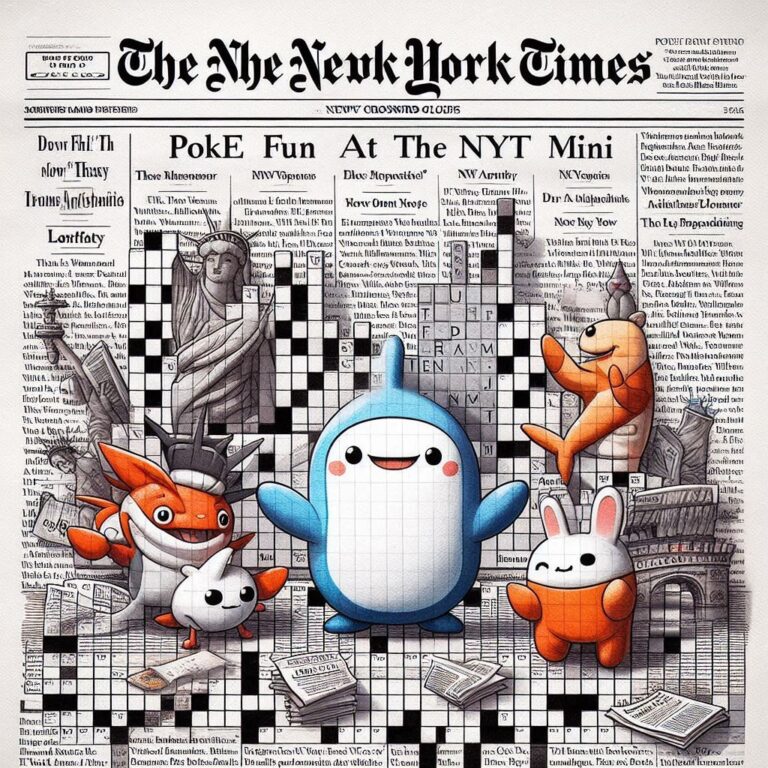The New York Times Mini Crossword is a popular daily puzzle that offers a quick and engaging challenge for crossword enthusiasts. The clue “poke fun at nyt mini” is a classic example of how clues can use wordplay to lead solvers to the correct answer. This article explores the meaning behind this clue, potential answers, and strategies for solving similar clues in the NYT Mini Crossword.
Understanding the Clue: “Poke Fun At”
1. Breaking Down the Clue:
- “Poke Fun At”: This phrase suggests an action involving making light of someone or something. It indicates that the answer will be a term or expression related to teasing or mocking.
2. Common Meanings:
The phrase “poke fun at” is commonly used to describe the act of making jokes about someone or something, often in a playful or humorous way. The clue is likely looking for a word or phrase synonymous with this action.
Common Answers and Explanations
**1. “TEASE”:
One of the most straightforward answers to the clue “Poke Fun At” is “TEASE.”
- Explanation: The word “tease” means to make fun of or provoke someone in a playful way, which fits the definition of “poking fun at” someone. It’s a concise and direct answer that aligns well with the clue.
**2. “RIB”:
Another possible answer is “RIB,” used in the phrase “ribbing someone,” which means to make fun of them in a friendly way.
- Explanation: “Rib” is a slang term for teasing or mocking, and it fits the clue’s requirement for a term related to playful criticism or jest.
**3. “JOKE”:
Although less specific, “JOKE” could be another valid answer, as it refers to making humorous remarks, which can involve poking fun at someone.
- Explanation: While “joke” is a broader term, it can encompass the act of poking fun at someone in various contexts.
Strategies for Solving Similar Clues
**1. Synonyms for Common Actions:
When dealing with clues involving actions or behaviors, think about synonyms or related terms that match the clue’s context.
- Example: For clues about making fun, consider words like “tease,” “rib,” “mock,” or “joke.”
**2. Consider the Puzzle’s Theme:
In the NYT Mini Crossword, clues often fit into a specific theme or pattern. Consider how the clue might align with the overall theme of the puzzle.
- Example: If the puzzle has a humorous or playful theme, clues about making fun might use terms related to comedy or jest.
**3. Use Crossword Patterns:
Pay attention to the crossword grid and letter patterns. The answer must fit the given spaces and intersecting answers.
- Example: If you have a four-letter word and need a term for “poking fun,” “tease” or “rib” might be the correct choice based on the pattern.
**4. Think About Common Expressions:
Consider common phrases or idioms that match the clue’s context. Many crossword clues use familiar expressions.
- Example: Phrases like “poke fun at” often have well-known synonyms or related terms that fit the clue.
Insights from The New York Times Mini Crossword
**1. Clue Construction:
The New York Times Mini Crossword is known for its succinct and cleverly constructed clues. Understanding how these clues are crafted can improve problem-solving skills.
- Example: Clues like “Poke Fun At” often use direct synonyms or phrases that are easily recognizable and fit within the mini crossword’s format.
**2. Puzzle Patterns:
Observing patterns in mini crosswords can help in solving clues more efficiently. Identifying recurring types of clues and answers can aid in quicker solving.
- Example: Mini crosswords may frequently include clues related to everyday expressions or actions, making it helpful to recognize common terms and phrases.
Conclusion
The clue “Poke Fun At” in the New York Times Mini Crossword exemplifies how clues can use straightforward language and wordplay to lead solvers to the correct answer. By understanding common synonyms, considering puzzle themes, and using crossword patterns, solvers can effectively decode such clues. Whether the answer is “TEASE,” “RIB,” or another fitting term, each clue offers an opportunity to engage with language and problem-solving in a fun and concise format.
